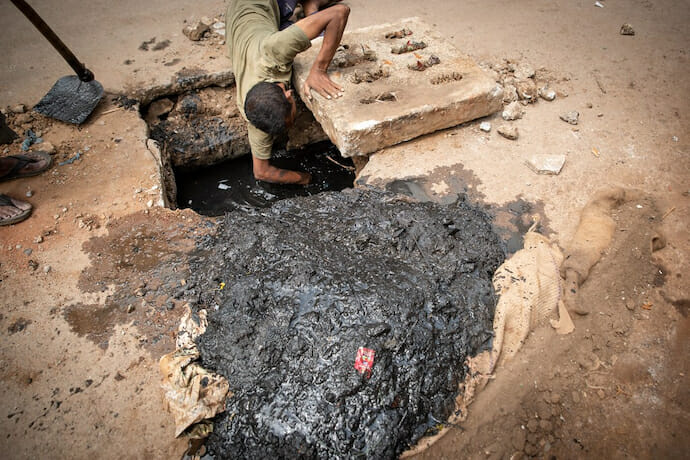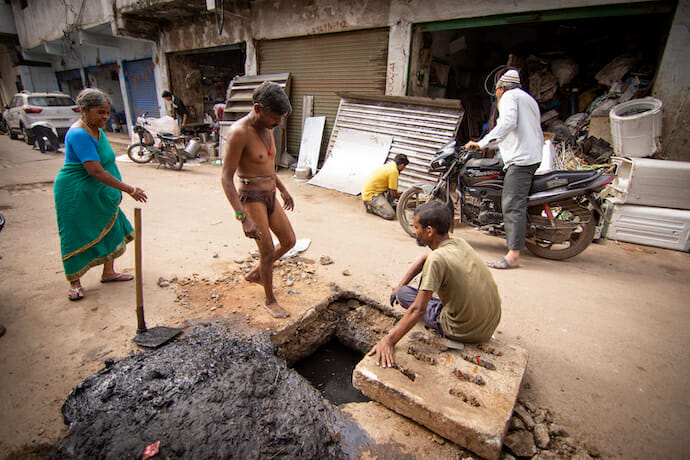The Platform
Latest Articles
by Kanan Heydarov
by Khalid Cherkaoui Semmouni
by Rasel Hossen Shakib
by Gordon Feller
by Collins Chong Yew Keat
by James Carlini
by Pitamber Kaushik
by Theo Casablanca
by Ikram Ali
by Eva Kneifel
by Kanan Heydarov
by Khalid Cherkaoui Semmouni
by Rasel Hossen Shakib
by Gordon Feller
by Collins Chong Yew Keat
by James Carlini
by Pitamber Kaushik
by Theo Casablanca
by Ikram Ali
by Eva Kneifel
Manual Scavenging in India: An Endless Cycle of Broken Promises
Manual scavengers and sanitation workers in India by and large live miserable lives.
In a scene from The Shawshank Redemption, Andy Dufresne (played by Tim Robbins) escapes Shawshank Prison by crawling his way through a sewage pipe. As his friend Red puts it, “Andy crawled to freedom through five hundred yards of shit-smelling foulness I can’t even imagine. Or maybe I just don’t want to. Five hundred yards. That’s the length of five football fields, just shy of half a mile.” But ultimately, Andy found his freedom.
Unfortunately, the manual scavengers and sanitation workers in India have a similar fate. The only difference is that they have to go through such sewers, fecal sludge, and filth every single day, for almost their entire lives and yet, find no redemption.
As many as 282 people have died while cleaning sewers and septic tanks in the country between January 2016 and November 2019, according to data cited by the government. Nearly 63,000 manual scavengers have been identified from December 2013 to January 2020. The Safai Karamchari Andolan (SKA) claims that the official data is just the tip of the iceberg. The actual number of deaths, as well as the people involved in manual scavenging, is much higher.
The practice of manual scavenging has been prevalent in India for centuries. In the past, it involved removing human excreta from dry pits and latrines but with modern sanitation, it additionally includes manual cleaning of drains, sewer lines, septic tanks, and even railway tracks, only making it more hazardous.
Despite a 1993 law banning manual scavenging and thereafter its amendment in 2013 with stringent measures, manual scavenging persists and workers continue to lose their lives due to asphyxiation by cleaning hazardous septic tanks and drains.
Another amendment was proposed in 2020 but the draft of the bill is not available for public consumption. A new bill aims to modernise sewer cleaning, provide protective gear to workers, and compensation.

The bill appears to be promising but on a detailed analysis and considering ground reports of existing conditions, the promises look very hollow. Existing legislation has hardly made any difference.
The major issue involved in the rehabilitation of manual scavengers is that of accounting for the number of people involved. State governments and district administrations have been reluctant to identify manual scavengers to save their reputation. According to data provided by the National Safai Karamcharis Finance and Development Corporation (NSKFDC), 4,757 people in 16 districts of Bihar identified themselves as manual scavengers, but the state government has refused to categorise any of them in the bracket of manual scavenging.
The 2013 law makes engaging any person for hazardous cleaning of sewers a punishable offence. The new bill aims at increasing the imprisonment term and the penalties. However, there is no record of the punishments faced by those employing manual scavengers in the past. This makes the ban a futile exercise. There is no deterrence created against employing manual scavengers as the law fails to set a precedent.
On average, manual scavengers are paid approximately $3 dollars per month per household, according to SKA data. Their lifespan is only about 40-45 years as they face multiple health problems like hepatitis, cholera, typhoid, skin infections, cancers, and cardiovascular issues. This deteriorates their economic conditions further.
The policy of rehabilitation has turned a blind eye to the caste factor in manual scavenging. Almost 98 percent of the people involved in manual scavenging are women and Dalits. Doesn’t this amount to caste and gender oppression? The law does not acknowledge this historic injustice and thus, manual scavenging continues to be a caste-based occupation, employing people to clean the filth by the virtue of their birth.
The present rehabilitation policy has three aspects. Firstly, one-time cash-based assistance of nearly $550 dollars will be granted to manual scavengers. How a household is supposed to survive or build upon such a small amount remains an unanswered question.

Secondly, skills training is assured to the beneficiaries for two years with a stipend of $40 dollars per month. Meenakshi, an illiterate daughter of a manual scavenger from Uttar Pradesh is a beneficiary of this program. She left the skills training as she struggled to operate a computer to learn Java and Tally. The relevance of the skills imparted is highly questionable.
Thirdly, subsidized loans will be offered to such families. But this comes with no orientation as to how the loan can be used to build a house, for education, or for other investments. It appears that the purpose of the policy has been to merely facelift the data and not to improve the living conditions of the manual scavengers. There is a need for an outcome-based policy.
For instance, under the Swachh Bharat Mission, many toilets have been built across the country but there is no sanitation due to lack of water, improper disposal practices, and no behavioural change in the people. This has once again burdened the sanitation workers to manually clean the human excreta in the toilets. Such policies fail to have a substantial outcome.
The first step in the right direction would be to survey and identify manual scavengers. To understand their problems, the government has to take up a bottom-up approach in consultation with groups like SKA. The caste factor, gender discrimination, and social stigma involved in this occupation cannot be ended unless it is recognised.
The law must be enforced stringently with reporting and fast-tracking of cases against those employing manual scavengers. The policy should not be restricted to manual scangers alone but needs to be more inclusive. Sanitation workers involved in cleaning bio-medical and other hazardous waste are equally at a risk. The mere provision of safety gear is not enough. The mechanisation of sewer cleaning with new technologies like robotics must be accelerated. The policy should be implemented in letter and spirit.
The government needs to move from a welfare-based approach towards an “empowerment approach” as suggested by Amartya Sen. Empowering the manual scavengers in a holistic manner, by providing them with alternative livelihood opportunities, relevant skills, and education and healthcare benefits are the need of the hour. The sanitation policy in India can be successful only if it takes care of the sanitation workers.
The practice of manual scavenging is dehumanising and must be completely eradicated. The right to life and dignity under Article 21 of the constitution for manual scavengers in the country is long overdue. There is a long way to go. But as Andy says, “Hope is a good thing.”
Prajakta Sawant hold a Master’s degree in Political Science. She has qualified for the Junior Research Fellowship, University Grants Commission, India and aspires to pursue a doctorate in International Relations.
